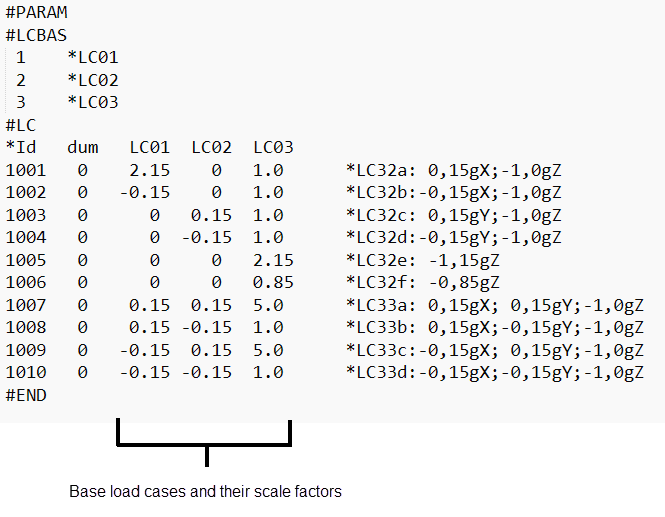Create Derived Load Cases
Use the Loadcase tool to create derived load cases by scaling and combining FE result subcases.
Create Linear Superposition Load Cases
-
From the Home tools, click the Loadcase tool.
Figure 1. 
The Derived Load Cases dialog opens. - Select LSP from the Type drop-down menu at the top of the dialog.
-
Add or remove the base load cases to be scaled and combined.
- Select a combination of load cases from the list on the left of the
dialog then click
 to add to
your selection.
to add to
your selection. - Select subcases on the right side of the dialog then click
 to remove
them from your selection.
to remove
them from your selection. - Click Clear to reset you selection completely.
- Select a combination of load cases from the list on the left of the
dialog then click
- On the right side of the dialog, edit the Scale values for your selection.
-
Click Create.
The subcases are combined to create a new derived new load case, which now appears on the left side of the dialog.
Tip: Once derived load cases are created, they can be selected, scaled, and
combined with a combination of other load cases.
Create LSP Load Cases From a Load Combination File
In addition to creating linear superposition load cases manually, you can also input a load combination file which will automatically create them for you.
-
From the Home tools, click the Loadcase satellite tool.
Figure 2. 
-
In the dialog, click
 and
browse for a load combination file (.lcf) that contains the
details of the fatigue load case combinations.
and
browse for a load combination file (.lcf) that contains the
details of the fatigue load case combinations.
-
Click
 to import the file.
to import the file.
#PARAM and should contain
the following data in the sequence mentioned below:- An
#LCBAStag to indicate the start of base load case definitions. - Base load case data that are to be used in HyperLife Weld Certification – first the ID and then the name, as in the example below. It's required to specify the base load cases for HyperLife Weld Certification to understand which bases cases are used in combinations.
- An
#LCtag to indicate the start of the load combination data. - Load combination data, as shown in the example below.

Create Envelope Load Cases
Note: Envelope load cases are essential during the weld screening process.
-
From the Home tools, click the Loadcase tool.
Figure 4. 
The Derived Load Cases dialog opens. - Select Envelope from the Type drop-down menu at the top of the dialog.
- Select whether to create a Min or Max stress envelope from the second drop-down menu.
-
Add or remove the base load cases to be scaled and combined.
- Select a combination of load cases from the list on the left of the
dialog then click
 to add to
your selection.
to add to
your selection. - Select subcases on the right side of the dialog then click
 to remove
them from your selection.
to remove
them from your selection. - Click Clear to reset you selection completely.
- Select a combination of load cases from the list on the left of the
dialog then click
- On the right side of the dialog, edit the Scale values for your selection.
- Using the drop-down menus at the bottom of the dialog, select a result data type and a base component for the which the envelope is to be evaluated.
-
Click Create.
The subcases are combined to create a new derived new load case, which now appears on the left side of the dialog.
Tip: Once derived load cases are created, they can be selected, scaled, and
combined with a combination of other load cases.
Review Load Cases
-
From the Home tools, click the Loadcase tool.
Figure 5. 
The Derived Load Cases dialog opens. - From the left side of the dialog, select a derived load case that you have created.
-
Right-click and select Review.
The combination of subcases used, along with their scale values, is displayed on the right side of the dialog.
Delete Load Cases
-
From the Home tools, click the Loadcase tool.
Figure 6. 
The Derived Load Cases dialog opens. - From the left side of the dialog, select derived load cases that you have created.
- Right-click and select Delete.